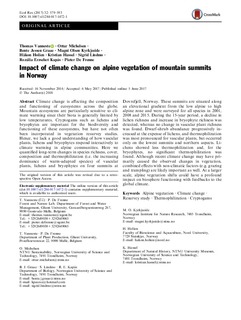| dc.contributor.author | Vanneste, Thomas | |
| dc.contributor.author | Michelsen, Ottar | |
| dc.contributor.author | Graae, Bente Jessen | |
| dc.contributor.author | Kyrkjeeide, Magni Olsen | |
| dc.contributor.author | Holien, Håkon | |
| dc.contributor.author | Hassel, Kristian | |
| dc.contributor.author | Lindmo, Sigrid | |
| dc.contributor.author | Kapás, Rozália Erzsebet | |
| dc.contributor.author | De Frenne, Pieter | |
| dc.date.accessioned | 2018-04-06T10:01:07Z | |
| dc.date.available | 2018-04-06T10:01:07Z | |
| dc.date.created | 2017-06-06T12:34:10Z | |
| dc.date.issued | 2017 | |
| dc.identifier.citation | Vanneste, T., Michelsen, O., Graae, B. J. Kyrkjeeide, M. O., Holien, H., Hassel, K., . . . De Frenne, P. (2017). Impact of climate change on alpine vegetation of mountain summits in Norway. Ecological research, 32(4), 579-593. doi: | nb_NO |
| dc.identifier.issn | 1440-1703 | |
| dc.identifier.uri | http://hdl.handle.net/11250/2493014 | |
| dc.description.abstract | Climate change is affecting the composition and functioning of ecosystems across the globe. Mountain ecosystems are particularly sensitive to climate warming since their biota is generally limited by low temperatures. Cryptogams such as lichens and bryophytes are important for the biodiversity and functioning of these ecosystems, but have not often been incorporated in vegetation resurvey studies. Hence, we lack a good understanding of how vascular plants, lichens and bryophytes respond interactively to climate warming in alpine communities. Here we quantified long-term changes in species richness, cover, composition and thermophilization (i.e. the increasing dominance of warm-adapted species) of vascular plants, lichens and bryophytes on four summits at Dovrefjell, Norway. These summits are situated along an elevational gradient from the low alpine to high alpine zone and were surveyed for all species in 2001, 2008 and 2015. During the 15-year period, a decline in lichen richness and increase in bryophyte richness was detected, whereas no change in vascular plant richness was found. Dwarf-shrub abundance progressively increased at the expense of lichens, and thermophilization was most pronounced for vascular plants, but occurred only on the lowest summits and northern aspects. Lichens showed less thermophilization and, for the bryophytes, no significant thermophilization was found. Although recent climate change may have primarily caused the observed changes in vegetation, combined effects with non-climatic factors (e.g. grazing and trampling) are likely important as well. At a larger scale, alpine vegetation shifts could have a profound impact on biosphere functioning with feedbacks to the global climate. | nb_NO |
| dc.language.iso | eng | nb_NO |
| dc.publisher | Springer | nb_NO |
| dc.rights | Navngivelse 4.0 Internasjonal | |
| dc.rights.uri | http://creativecommons.org/licenses/by/4.0/deed.no | |
| dc.subject | Klimaendringer | nb_NO |
| dc.subject | Climate change | nb_NO |
| dc.title | Impact of climate change on alpine vegetation of mountain summits in Norway | nb_NO |
| dc.type | Journal article | nb_NO |
| dc.type | Peer reviewed | nb_NO |
| dc.description.version | acceptedVersion | nb_NO |
| dc.rights.holder | © 2017, The Author(s) | |
| dc.subject.nsi | VDP::Zoologiske og botaniske fag: 480 | nb_NO |
| dc.subject.nsi | VDP::Zoology and botany: 480 | nb_NO |
| dc.source.pagenumber | 579-593 | nb_NO |
| dc.source.volume | 32 | nb_NO |
| dc.source.journal | Ecological research | nb_NO |
| dc.source.issue | 4 | nb_NO |
| dc.identifier.doi | 10.1007/s11284-017-1472-1 | |
| dc.identifier.cristin | 1474227 | |
| dc.relation.project | GLORIA Europe EC/FP5 | nb_NO |
| dc.relation.project | Miljødirektoratet | nb_NO |
| dc.description.localcode | Paid Open Access | |

